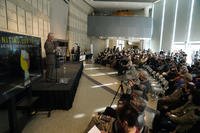Real-life laser weapons continue to inch closer to reality. Two recent examples: Raytheon says its "prototype solid-state Laser Area Defense System (LADS) successfully detonated 60-millimeter mortars." And Northrop Grumman is opening up a new "directed energy production facility" for building high energy, solid-state lasers. Raytheon's announcement is interesting, because solid-state, electric lasers haven't yet hit the 100 kilowatt threshold which many people consider to be the minimum strength for weapons-grade lasers. (They're not too far off, though.) But Raytheon says they zapped these mortars using "an a proven, existing, off-the-shelf solid-state laser, coupled with commercially available optics technology."
Raytheon's announcement is interesting, because solid-state, electric lasers haven't yet hit the 100 kilowatt threshold which many people consider to be the minimum strength for weapons-grade lasers. (They're not too far off, though.) But Raytheon says they zapped these mortars using "an a proven, existing, off-the-shelf solid-state laser, coupled with commercially available optics technology."
So how did the company pull it off? I got a non-answer from a company flack, something about "view[ing] the problem from the user point of view."
Now, this was a very limited test. These mortars were small -- just 60 mm. The company wouldn't say how long they were zapped (even a weak laser can bore holes in metal, given enough time). And the mortars were on the ground, around 550 yards away, not flying through the air. But this LADS is built on the back on Raytheon's 4,500-round-per-minute Phalanx gun, which is already knocking down mortars in Iraq. So presumably, the targeting and tracking piece is won't be that hard to manage. In-air tests of the laser are planned for later this year.
Meanwhile, Northrop has opened up a new facility, south of Los Angeles, to build what the company hopes is the world's first 100 kilowatt, solid-state laser. It'll start by putting together the series of 32 garnet crystal "modules" that form the heart of the system. Shine light-emitting diodes into 'em, and they start the laser chain-reaction, shooting out focused light. Combine all those beams into one, and you've got yourself a battlefield-strength ray. The array is similar to what Northrop used in its 25 kw demonstrator. But the gum-stick-sized crystals have been shrunk by about 50% -- part of the company's effort to make the laser small and rugged enough for war zone use.
50 people should be hired over the next year in the new facility. Company officials say they're still on track on demonstrate their 100 kw laser by the end of next year. If everything works according to plan, there should be enough room in the new building to simultaneously build and test three weapons-grade lasers at once.
Electric Lasers Shoot Mortars, Gain Strength
© Copyright 2024 Military.com. All rights reserved. This article may not be republished, rebroadcast, rewritten or otherwise distributed without written permission. To reprint or license this article or any content from Military.com, please submit your request here.








